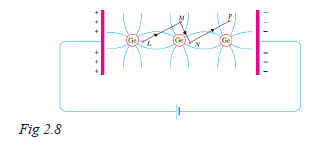- At room temperature, some of the covalent bonds in pure semiconductor break, setting up free electrons. Under the influence of electric field, these free electrons constitute electric current. At the same time, another current – the hole current – also flows in the semiconductor. When a covalent bond is broken due to thermal energy, the removal of one electron leaves a vacancy i.e. a missing electron in the covalent bond. This missing electron is called a hole which acts as a positive charge. For one electron set free, one hole is created. Therefore, thermal energy creates hole-electron pairs; there being as many holes as the free electrons.
- The current conduction by holes can be explained as follows: The hole shows a missing electron. Suppose the valence electron at L (See Fig. 2.8) has become free electron due to thermal energy. This creates a hole in the covalent bond at L.
- The hole is a strong centre of attraction for the electron. A valence electron (say at M) from nearby covalent bond comes to fill in the hole at L. This results in the creation of hole at M. Another valence electron (say at N) in turn may leave its bond to fill the hole at M, thus creating a hole at N. Thus the hole having a positive charge has moved from L to N i.e. towards the negative terminal of supply. This constitutes hole current.
- It may be noted that hole current is due to the movement of valence electrons from one covalent bond to another bond. One may wonder why to call it a hole current when the conduction is again by electrons (of course valence electrons!). The answer is that the basic reason for current flow is the presence of holes in the covalent bonds. Therefore, it is more appropriate to consider the current as the movement of holes.

Wilfykil answered the question on
August 13, 2019 at 12:42